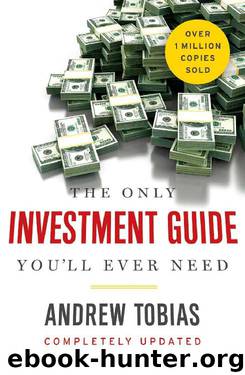The Only Investment Guide You'll Ever Need by Andrew Tobias

Author:Andrew Tobias [Tobias, Andrew]
Language: eng
Format: epub, mobi, azw
Publisher: Houghton Mifflin Harcourt
Published: 2016-04-26T06:00:00+00:00
For shares of a dull company whose earnings over the long run seem about as likely to increase as to fall—where risk and reward about cancel one another out—you might expect to pay 20 times earnings. So if you find such a stock selling for 10 or 12 times earnings, it could look pretty good.
For stock in a company whose earnings seem likely to be able to keep pace with inflation—no “real” growth, that is, but growth in earnings all the same—you might expect to pay more than the 20 times earnings you would pay for a high-grade bond, the earnings of which do not rise with inflation. In fact, some such companies sold at five or six times earnings back in 1974 and 1982. A bargain? You bet.
Finally, for stock in a company whose prospects are really bright, with the possibility of real growth, above inflation, of 5% or 10% or even 20% a year for the foreseeable future, you might expect to pay a lot more than 20 times earnings.
All other things being equal—that is, if all stocks were selling at 20 times earnings—you would choose only those companies whose earnings were expected to grow the fastest. But the question is not whether a fast-growing company is better than a slow-growing one. Any fool knows that. The question is whether you should pay 35 times earnings for the one or 12 times earnings for the other. Which stock, at any given time, is a better relative value? The real trick—and payoff—is to find a company selling for 12 times earnings that you think will grow as fast as the one selling for 35 times earnings. Then you know for sure which to buy.
Admittedly, it’s not quite this simple. For one thing, it makes sense to look not just at what a company may earn but also at what it owns. A company whose business is lousy, but which happens to be conducted on 50,000 acres of wholly owned real estate between Dallas and Fort Worth, might have a liquidation value—if you closed down the business and paid off all the creditors—of $25 a share. Yet such land, if it had been ac quired early in the last century, might be valued on the company’s books at next to nothing—so it might not even show up in quick calculations of the company’s “book value.” It could be what’s known as a hidden asset, and well worth buying shares in, regardless of the company’s dismal earnings.
I should also stress that the 20 times earnings I’ve been using as a benchmark is by no means eternal. It all depends on what wallets are going for at any given time. If you can get 15% from a high-grade bond, as you could in 1982, then you have a low-risk wallet that produces $1 for every $6.67 you put up—6.7 times earnings. The higher the prevailing long-term interest rate, the less you should be willing to pay for stocks. And vice versa. That old seesaw again.
Download
The Only Investment Guide You'll Ever Need by Andrew Tobias.mobi
The Only Investment Guide You'll Ever Need by Andrew Tobias.azw
This site does not store any files on its server. We only index and link to content provided by other sites. Please contact the content providers to delete copyright contents if any and email us, we'll remove relevant links or contents immediately.
| Budgeting & Money Management | College & Education Costs |
| Credit Ratings & Repair | Retirement Planning |
The Compound Effect by Darren Hardy(8806)
Tools of Titans by Timothy Ferriss(8213)
Nudge - Improving Decisions about Health, Wealth, and Happiness by Thaler Sunstein(7613)
Win Bigly by Scott Adams(7094)
Deep Work by Cal Newport(6877)
Rich Dad Poor Dad by Robert T. Kiyosaki(6398)
Pioneering Portfolio Management by David F. Swensen(6226)
Principles: Life and Work by Ray Dalio(6204)
The Barefoot Investor by Scott Pape(5698)
Digital Minimalism by Cal Newport;(5661)
Grit by Angela Duckworth(5512)
The Slight Edge by Jeff Olson(5346)
Discipline Equals Freedom by Jocko Willink(5279)
The Motivation Myth by Jeff Haden(5155)
You Are a Badass at Making Money by Jen Sincero(4866)
The Four Tendencies by Gretchen Rubin(4544)
Eat That Frog! by Brian Tracy(4430)
The Confidence Code by Katty Kay(4187)
Bullshit Jobs by David Graeber(4094)
